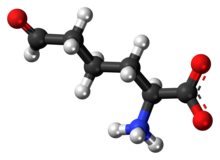Allysine

| |

| |
| Names | |
|---|---|
| Preferred IUPAC name
(2S)-2-Amino-6-oxohexanoic acid | |
| Other names
2-aminoadipate semialdehyde, 2-amino-5-formylvaleric acid, norvaline, 6-oxo-DL-norleucine
| |
| Identifiers | |
3D model (JSmol)
|
|
| ChEBI | |
| ChemSpider | |
| KEGG | |
| MeSH | allysine |
PubChem CID
|
|
| UNII | |
| |
| |
| Properties | |
| C6H11NO3 | |
| Molar mass | 145.158 g·mol−1 |
| Density | 1.74g/cm3 |
| Boiling point | 295.2 °C (563.4 °F; 568.3 K) |
| Hazards | |
| Flash point | 132.3 °C (270.1 °F; 405.4 K) |
Except where otherwise noted, data are given for materials in their standard state (at 25 °C [77 °F], 100 kPa). | |
| Infobox references | |
Allysine is a derivative of lysine, used in the production of elastin and collagen. It is produced by the actions of the enzyme lysyl oxidase in the extracellular matrix and is essential in the crosslink formation that stabilizes collagen and elastin.[1]
Clinical relevance[]
Large quantities of elastin and collagen present in tissue may lead to metastasis: spread of disease. Fibrous tissue containing oxidized collagen may result in a condition known as fibrosis. The oxidation of lysine residues present in collagen creates the aldehyde, aminoadipic-δ-semialdehyde (allysine). Increased allysine concentration in tissues has been correlated to the presence of fibrosis.[2] To qualify protein carbonyls in biological systems, most research studies use the dinitrophenylhydrazine (DNPH) process. The study of particular protein carbonyls, such as allysine, reveals more about specific redox processes and mechanisms at the molecular level. [3] Allysine and its oxidation product, α- amino adipic acid (α-AA), have been discovered to also be diabetes risk indicators. To get a better understanding of this concept, human serum albumin was incubated for 32 hours at 37 degrees Celsius in the presence of FeCl3 (25 μM) and increasing glucose concentrations. Both allysine and α-AA levels were found to rise as glucose levels increased which lead to the depletion of tryptophan. Regarding the underlying functions of tryptophan and its metabolites, depletion of tryptophan and its metabolites may result in additional physiological problems such as coronary artery disease and neurological complications.[4]
Allysine quantification[]
Allysine can be reacted with sodium 2-naphthol-6-sulfonate to produce a fluorescent bis-naphtol allysine product. Allysine can then be quantified through use of high-performance liquid chromatography (HPLC). This method of detection was used show allysine has a 2.5 higher concentration in fibrotic vs. normal tissue.[5]
See also[]
References[]
- ^ Pinnell SR, Martin GR (October 1968). "The cross-linking of collagen and elastin: enzymatic conversion of lysine in peptide linkage to alpha-aminoadipic-delta-semialdehyde (allysine) by an extract from bone". Proceedings of the National Academy of Sciences of the United States of America. 61 (2): 708–16. Bibcode:1968PNAS...61..708P. doi:10.1073/pnas.61.2.708. PMC 225217. PMID 5246001.
- ^ Wahsner J, Désogère P, Abston E, Graham-O'Regan KA, Wang J, Rotile NJ, et al. (April 2019). "68Ga-NODAGA-Indole: An Allysine-Reactive Positron Emission Tomography Probe for Molecular Imaging of Pulmonary Fibrogenesis". Journal of the American Chemical Society. 141 (14): 5593–5596. doi:10.1021/jacs.8b12342. PMC 6494104. PMID 30908032.
- ^ Luna C, Estévez M (January 2019). "Formation of allysine in β-lactoglobulin and myofibrillar proteins by glyoxal and methylglyoxal: Impact on water-holding capacity and in vitro digestibility". Food Chemistry. 271: 87–93. doi:10.1016/j.foodchem.2018.07.167. PMID 30236745. S2CID 52309183.
- ^ Luna C, Arjona A, Dueñas C, Estevez M (March 2021). "Allysine and α-Aminoadipic Acid as Markers of the Glyco-Oxidative Damage to Human Serum Albumin under Pathological Glucose Concentrations". Antioxidants. 10 (3): 474. doi:10.3390/antiox10030474. PMC 8002732. PMID 33802856.
- ^ Waghorn PA, Oliveira BL, Jones CM, Tager AM, Caravan P (October 2017). "High sensitivity HPLC method for determination of the allysine concentration in tissue by use of a naphthol derivative". Journal of Chromatography. B, Analytical Technologies in the Biomedical and Life Sciences. 1064: 7–13. doi:10.1016/j.jchromb.2017.08.032. PMC 5662445. PMID 28886479.
- Amino acids
- Aldehydes
- Aldehydic acids
- Biochemistry stubs